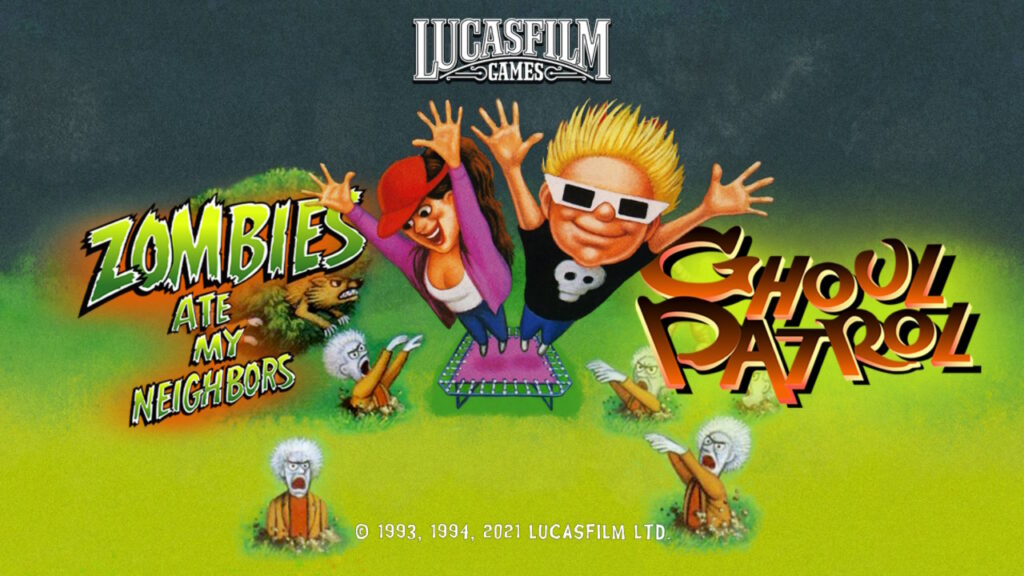
Zombies Ate My Neighbors has been an enduring cult classic Super Nintendo game since it released back in 1993. While it’s striking title certainly helped stay in the back of the brains of gamers, it was its addicting and challenging co-op gameplay that guaranteed its longevity. Compounded by a generous amount of levels and horror B-movie charm, it’s no wonder why it is so fondly remembered.
Ghoul Patrol is widely considered a sequel due to it having very similar gameplay and premise of Zombies Ate My Neighbors, but for some reason it never got the same love. It had bigger and more detailed sprites, with much livelier animations. The difficulty was a bit more fair; although that isn’t saying much for games from the 90s, which were typically much harder than anything released in the modern age.
Zombies Ate My Neighbors and Ghoul Patrol inevitably became extremely rare and highly sought after SNES cartridges that would cost the soul of an orphan. Things got worse when the Wii virtual shop closed, leaving the WiiU virtual console as the last option.
Thankfully, they have both been bundled together, and have been made available on modern platforms so gamers who grew up with them can relive the 90s.
Did Ghoul Patrol deserve its scorn, or was it a decent game living in the long shadow of its predecessor? Is Zombies Ate My Neighbors as good as everyone remembers, or is it full of unfair and cheap design? Does this duology honor the legacy of the original?
Zombies Ate My Neighbors and Ghoul Patrol
Developer: Lucasfilm Games, DotEmu
Publisher: Disney Interactive Studios
Platforms: Windows PC, Nintendo Switch (reviewed), PlayStation 4, Xbox One
Release Date: June 29, 2021
Players: 1-2
Price: $14.99 USD
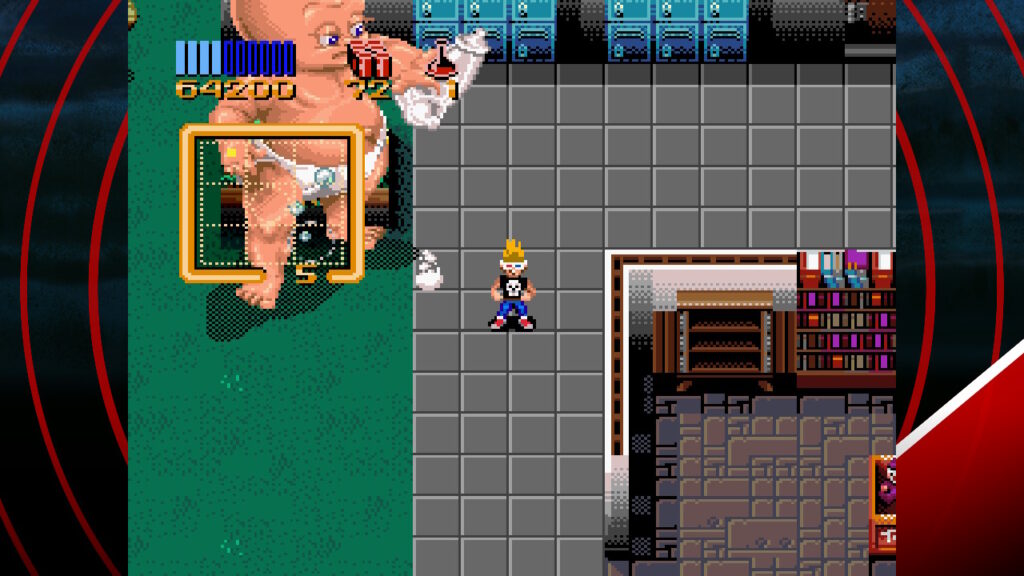
Zombies Ate My Neighbors is the story of Zeke and Julie, and how they thwart Dr. Tongue’s horde of lawyer-friendly movie monsters from murdering cheerleaders, army guys, dogs, babies, and tourists. There might have been a bit more substance to the story in the game’s manual, but the Zombies Ate My Neighbors and Ghoul Patrol combo only has scans of the manual covers, and not the good stuff inside.
Zombies Ate My Neighbors offers no context to anything that happens other than some mildly amusing names for every stage. Not that it makes the experience any less enjoyable; this is a game inspired by arcade action after all. No time is wasted before Zeke and Julie find themselves being hounded by chainsaw maniacs in a hedge maze like the end of The Shining.
Ghoul Patrol actually bothers to have some context to explain all the schlocky shenanigans. A cutscene with quaint 90s dialogue depicts Zeke and Julie at an exhibit, and they both read a passage that summons a demon; like the Necronomicon in the Evil Dead movies. This red guy brings with him all the forces of hell he can muster, so that the gameplay can be a lot like Zombies Ate My Neighbors.
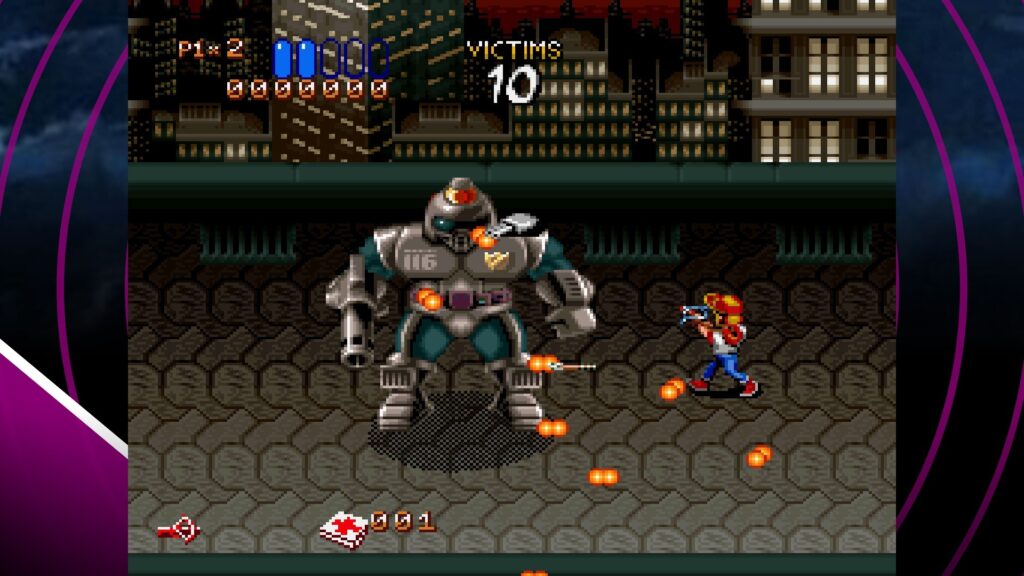
Zombies Ate My Neighbors and Ghoul Patrol delivers exactly what it says on the tin, and not much else. This is not a remastering of the Super Nintendo Entertainment System games at all; nor does it offer an impressive suite of extras, restored cut content like in SaGa Frontier Remastered, or revamped pixel art as seen in Wild Guns Reloaded or The Ninja Saviors: Return of the Warriors.
Zombies Ate My Neighbors and Ghoul Patrol on modern platforms can be generously described as a port. There are absolutely no enhancements added to either game; other than being able to save progress while quitting a session. While both games are enjoyable, both weren’t perfect and had room for improvement.
There was no effort to implement split-screen; which is disappointing considering Zombies Ate My Neighbors was originally intended to have it, but the developers couldn’t get the game running smoothly due to hardware limitations. Modern platforms don’t have the same limitations, which makes it all the more disappointing that the developers missed the opportunity to implement such a useful feature.
The extras are also lackluster. While we were promised concept art and interviews; we only got a few sketches, the covers of the manuals and box, and a single interview with one Zombies Ate My Neighbors developer on how hard it was to find a publisher, and how it led to so many levels. There’s nothing on Ghoul Patrol.
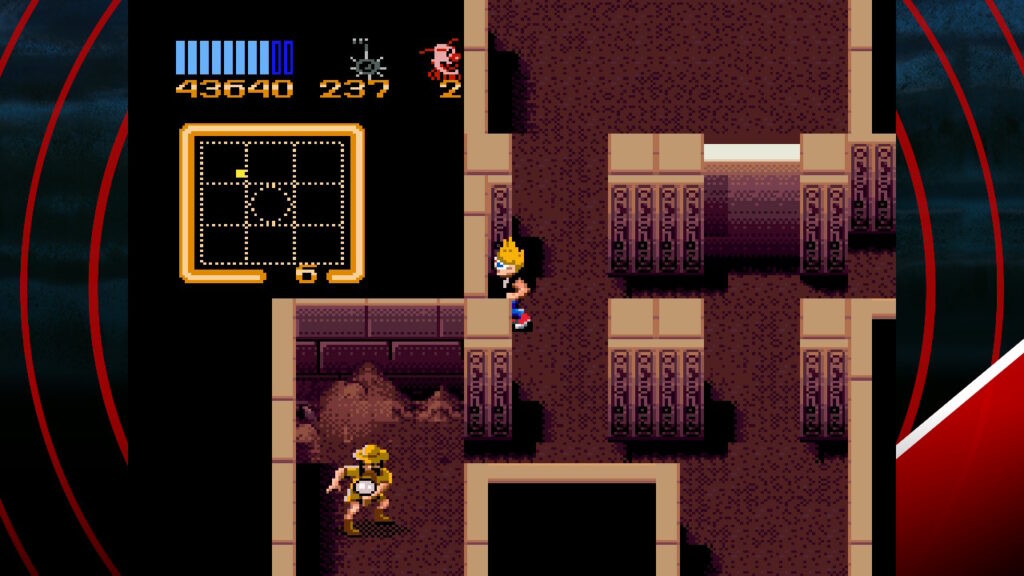
The objective in both titles revolves around exploring one large map and rescuing people. Picking up every survivor opens up an exit to continue to the next area. Where the two games differ is that Zombies Ate My Neighbors will spawn an exit door where the last survivor stood. Ghoul Patrol has the exit spawn at a specific location, and it’s on the player to find it.
Both design choices have their merits. Having the exit appear immediately is convenient, and keeps a steady flow of action. Having to follow signs for the general direction of the exit makes players more aware of the level’s layout and pay more attention, which can be engaging in its own right.
Both games will have Zeke and Julie square off with enormous bosses that fill the screen. Ghoul Patrol is actually much more fair with its boss encounters, as they are slower and are beatable with the most basic equipment. Zombies Ate My Neighbors will have huge targets that move unreasonably fast with huge HP pools.
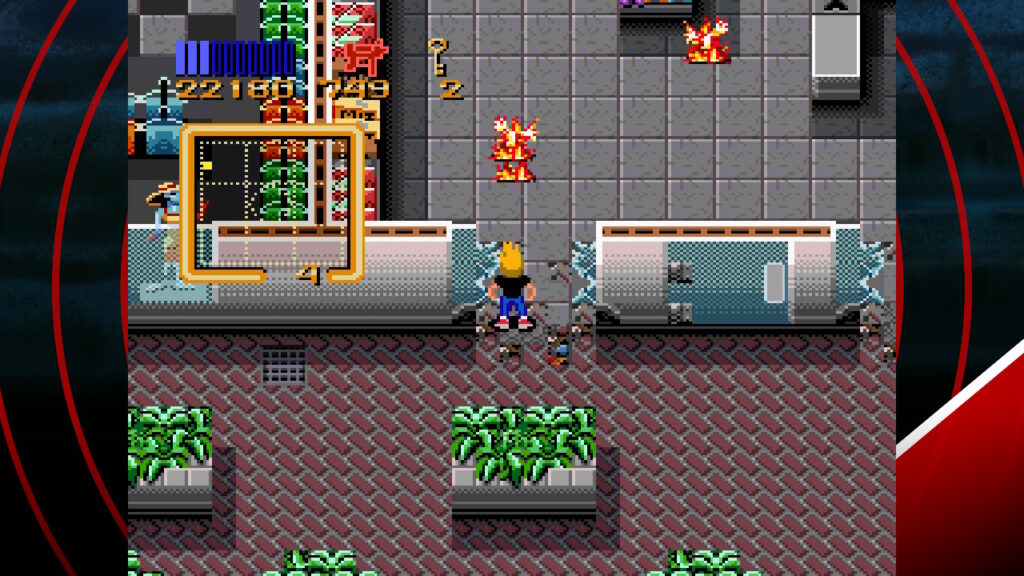
Fighting the giant baby is infamously difficult due to how he could stun lock the heroes by continuously stomping on them; taking most of, if not all their lives. Zombies Ate My Neighbors was the kind of game you didn’t feel bad when you cheated, because of how brutal and cruel it could be. It was also much longer than most gamers knew; boasting 48 stages, making every run a white-knuckle marathon of pure tension.
Ghoul Patrol is no where near as long; topping at a meager 17 stages. Zombies Ate My Neighbors may have a few levels that feel forgettable or sloppy recycled content, but 25 of them are excellent. These are areas that are dense with things to do and have memorable enemies. Sometimes it evokes classic Resident Evil due to all the resource management, key searching, and how areas wrap around each other.
Out of the 17 stages on Ghoul Patrol, about half of them are decent, and the rest can be obnoxious. Some areas go overboard with traps and the amount of things that can kill you.
The absolute worst is endlessly respawning enemies who flow into the screen immediately after one is killed. These points are typically placed in illogical and annoying places like narrow halls or crucial doorways, which can lead to very long stand-offs of endless shooting.

Both titles are certainly flawed with how enemies are handled. There are often too many to realistically handle even in co-op, and they have too much HP more often than not. Resources like health kits are rare, and while rummaging for anything certain chests or trash bins might have a monster lurking inside.
Waiting like a pervert looking for a victim, these freaks burst out of any searchable container and deal damage, quickly vanishing from the scene of the crime. All that can be done is to lay down and let these degenerates have their way and move on. There is no retribution and there is no way to prevent it. Zombies Ate My Neighbors and Ghoul Patrol teaches a harsh lesson; that we are all victims in waiting.
The password system in both titles is also very flawed. Zombies Ate My Neighbors and Ghoul Patrol were designed with an element of resource management in mind. The early parts of the games had more plentiful items to collect that would become lifesavers later on. Using a password would mean starting with nothing except a water gun at later levels; severely crippling chances of survival.
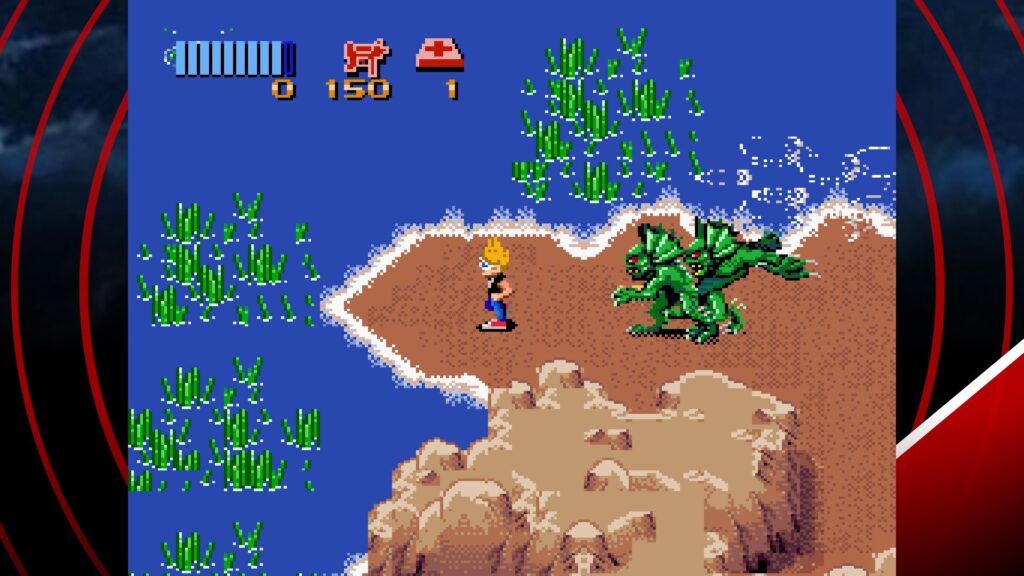
This port had the opportunity to improve upon the progression for both games. There could have been a level select menu for all previously completed stages. Both titles should have let players carry all of their left over resources that they were still carrying when they died. This would give them better odds at survival if they choose to restart a few levels back; so they can accrue more health kits, lives, and ammo.
Another missed opportunity is the lack of care put into the control mapping. There could have been twin-stick controls added or at the very least. Strafing may have broken the game, but it would have made fighting the giant baby and UFO a lot fairer. Sadly, there are no control options at all; and confusingly, the controls seemed to have been mixed up from the original game.
There was no effort at all to even out the difficulty or make the scenario more fair at all. All the same flawed systems are exactly as they were, and there is no option to remap the controls.
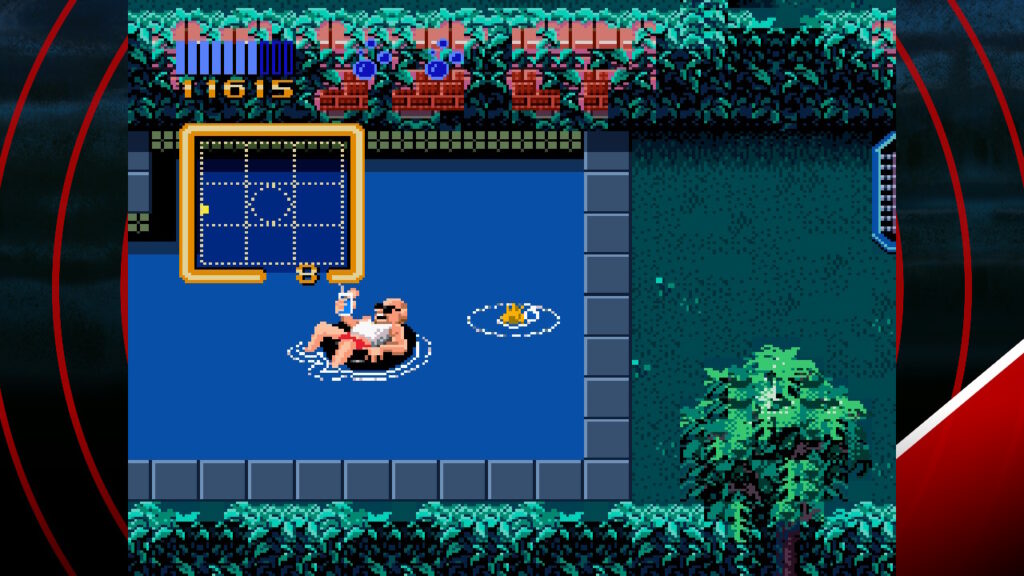
The biggest victim of all in the Zombies Ate My Neighbors and Ghoul Patrol package is the image quality. Both of these games are 16-bit SNES titles that were designed for 4:3 CRT displays, and not for 16:9 HD flat panels.
The pixel artists for both games used the limitations of the display hardware to craft the visuals, and now that the phosphorous glow is not present to smooth the pixel edges, the visuals become rough and jaggy. The art assets were never meant to be viewed in this manner, and this package offers absolutely no scalene filters of any kind.
The 4:3 aspect ratio has been preserved, but now horrible and ugly art is permanently fixed to the pillar boxed format. This port could have added a widescreen modification, since the levels are very large, and steps could have been taken to fill the entire screen with game real estate. There isn’t even any border options for simple black bars.
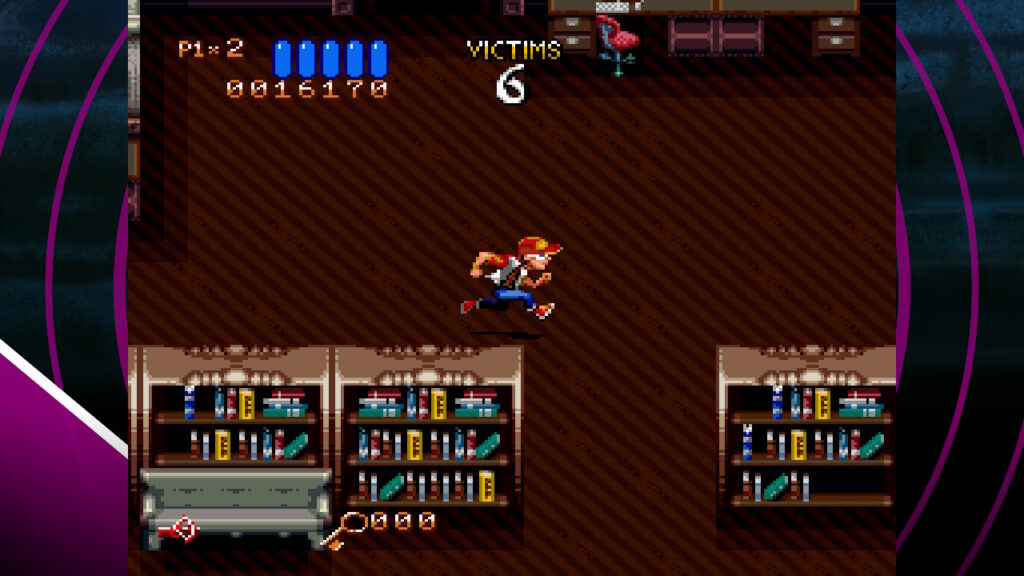
Even though Zombies Ate My Neighbors and Ghoul Patrol is very flawed, it’s still as engaging and enjoyable as ever. Zombies Ate My Neighbors is definitely the feature presentation of the package; boasting an unbelievably dense experience of mayhem and action. It constantly introduces new ideas and weird visuals, like using a lawn mower on aliens and victims who become werewolves.
Ghoul Patrol has undeniably got issues with its level design and being really short, but it’s no where near as bad as most will claim. Most complaints are levied at having to seek the exit after saving the survivors, but this seems like it helps make the game stand out from being too much like its predecessor.
The controls in Ghoul Patrol are noticeably slower and weightier. Characters are a lot more animated and expressive, so they have more drawn out movements. Some may be put off by this, but it’s not inherently bad; just an alternative to the must faster and snappier Zombies Ate My Neighbors.
Ghoul Patrol does have Zeke and Julie with a much wider range of abilities than they had in Zombies Ate My Neighbors, which is welcomed. They’re able to jump, sprint, and even dash for evasive maneuvers; helping to add variety to the action, and edge out the fairness when going up against a huge red demon.
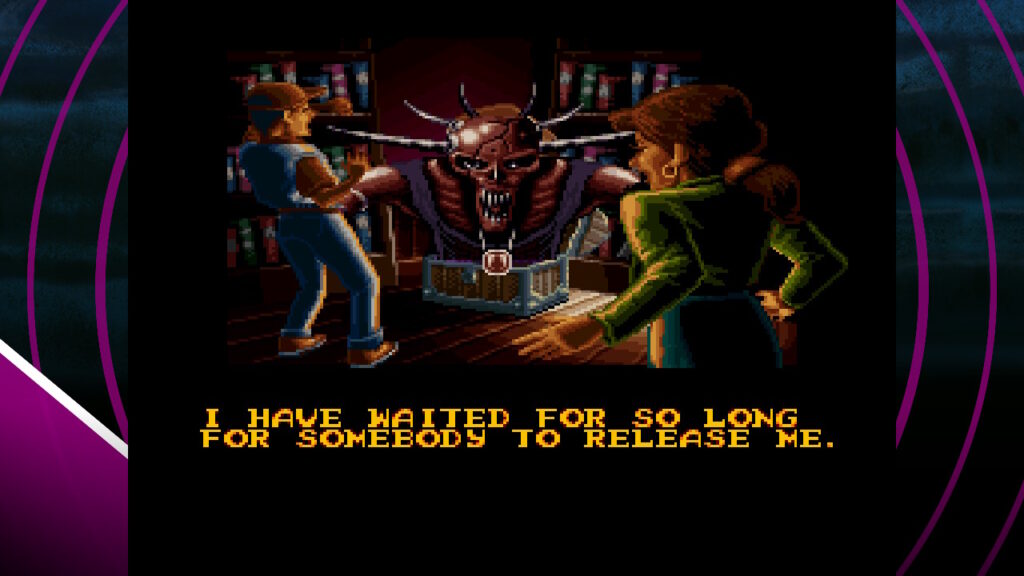
Zombies Ate My Neighbors and Ghoul Patrol are very charming and have a lot of personality. The former will be the reason to buy it, but latter should be given a chance to show how it made some improvements; like the jumping, presentation and sliding.
It’s too bad that this port on modern platforms addresses none of the main issues with both titles, and that there was no effort given to add any authenticity to the visuals’ image quality. The lack of quality of life improvements or enhancements will make these hard to return to, and will be impenetrable for newcomers.
The premise formula in Zombies Ate My Neighbors and Ghoul Patrol is a very solid foundation. If a new one is every made, the ways to improve upon them will be very obvious. For now, these classics can now be enjoyed and experienced by pretty much everyone, and hopefully inspire new game designers to not make the same mistakes.
Zombies Ate My Neighbors and Ghoul Patrol was reviewed on Nintendo Switch using a code purchased by Nichegamer. You can find additional information about Niche Gamer’s review/ethics policy here.